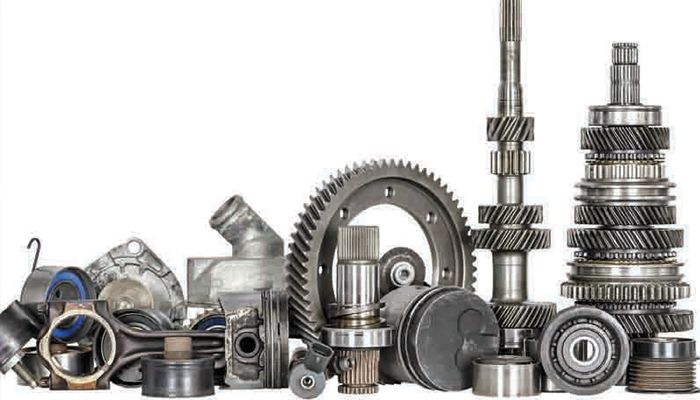
or

The claims of a patent relating to a machine would identify the specific components or elements that combine to make up the patented machine. Therefore, once the patent office issues a patent for the machine, the patentee has the right to exclude others, under Section 48 of the [Indian] Patent Act, 1970, from making, using, offering for sale, selling or importing any machine that contains all the components of any claim in the patent.
In this regard, it is important to note that the patentee has the right to prevent sale of all or any components of the patented machine as “spare parts”. In this regard, observation made in the case, titled Dunlop Pneumatic Tyre Company, Limited v. David Moseley & Sons, Limited, (1904) 1 Ch. 612 is notable, where the court held that, “If there was a patent for a knife of a particular construction, and an injunction was granted restraining a defendant from selling knives made according to the patent, and he was to sell the component parts so that any schoolboy could put them together and construct the knife, surely that sale would be a breach of the injunction.
A universal application of the above legal position would be rather complicated. On an illustrative basis in the case of patented products that have met their useful life and are in need of repair, a refurbisher will replace one or more parts to restore the machine and return it to its owner or resell the machine to others. The spare parts supplied typically constitute less than all of the claimed elements of a patented invention. The refurbisher views itself as merely a repairer of a spent device for which the patentee was already paid. The patentee, however, considers the refurbisher as effectively reconstructing the patented device and thus liable for patent infringement.
In an effort to resolve this historical dispute between original equipment manufacturers (OEMs) and refurbishers, courts established the principle that “repair” of a patented product is permissible, but “reconstruction” of the product is not (Aro Manufacturing, Co., Inc. v. Convertible Top Replacement Co., Inc., 81 S.Ct. 599).
In the Indian context, the test of infringement in these cases would be the determination of the nature of activity of the third party, i.e. whether it amounts to mere “repairing” of the patented product or it falls under the definition of“making” as per Section 48 of Patents Act, 1970.
Reference, in this regard is also placed on the decision rendered in Shutz (U.K) Limited v. Werit (U.K) Limited, [2013] UKSC 16,where it laid down the following principles to adjudge whether the replacing a part of patented machine amounts to repairing or making:
At present, the precedent is that such manufacturer or seller would not be held liable for any civil actionor for contributory infringement unless it is provedthat there has been direct infringement by the making of the patented product with those spare parts.
At present, the position in India is that if a patentee wants to prosecute a seller of spare parts of its patented product, he would have to show that the seller is selling all the parts. This undoubtedly affects a patentee’s right to enjoy his exclusive rights without any fear of its patent being infringed. Therefore, it becomes necessary for Courts to appreciate and consider thatifan entity/person engaged in manufacturing and sale of spare parts, whichare novelto the invention, is intentionally replacing the components of the patented product, the manufacturer and seller of such spare parts should be liable for direct infringement and not for contributory infringement.
Mohit Goel is a Partner at Sim And San. Mohit’s expertise extends to dispute resolution in the field of Intellectual Property Rights and Arbitration and Conciliation. Mohit has played and continues to play a key role in some of India’s biggest Intellectual Property disputes. Mohit is also an active member of the International Trademark Association (INTA).
Aditya Goel, is an associate with Sim and San, Attorneys At Law. He specializes in civil-commercial dispute resolution (particularly in the field of Intellectual Property Rights Law), and prosecution related assignment in the field of Trade Marks and Patents.

Lex Witness Bureau

Lex Witness Bureau

Lex Witness Bureau

For over 10 years, since its inception in 2009 as a monthly, Lex Witness has become India’s most credible platform for the legal luminaries to opine, comment and share their views. more...
Connect Us:


The Grand Masters - A Corporate Counsel Legal Best Practices Summit Series
www.grandmasters.in | 8 Years & Counting
The Real Estate & Construction Legal Summit
www.rcls.in | 8 Years & Counting
The Information Technology Legal Summit
www.itlegalsummit.com | 8 Years & Counting
The Banking & Finance Legal Summit
www.bfls.in | 8 Years & Counting
The Media, Advertising and Entertainment Legal Summit
www.maels.in | 8 Years & Counting
The Pharma Legal & Compliance Summit
www.plcs.co.in | 8 Years & Counting
We at Lex Witness strategically assist firms in reaching out to the relevant audience sets through various knowledge sharing initiatives. Here are some more info decks for you to know us better.
Copyright © 2020 Lex Witness - India's 1st Magazine on Legal & Corporate Affairs Rights of Admission Reserved